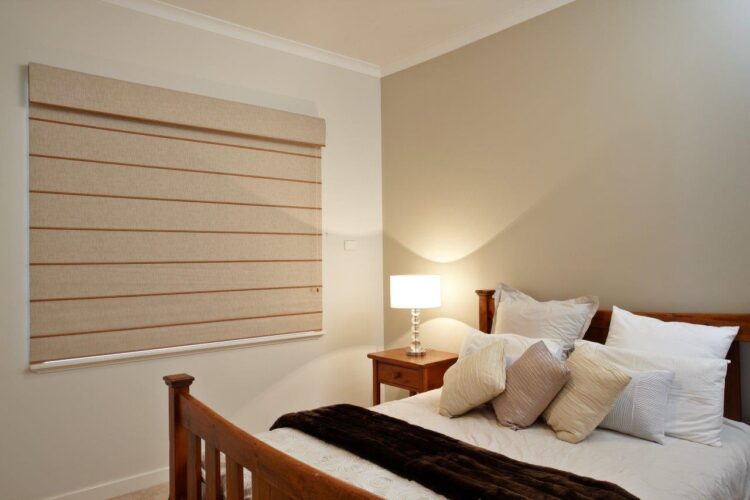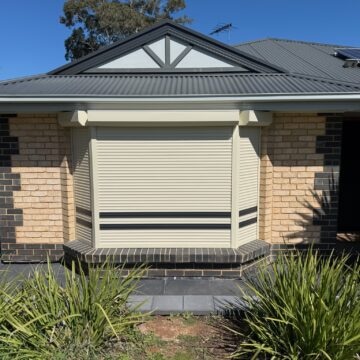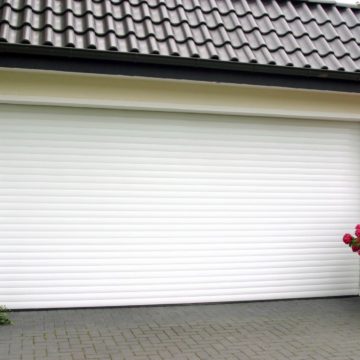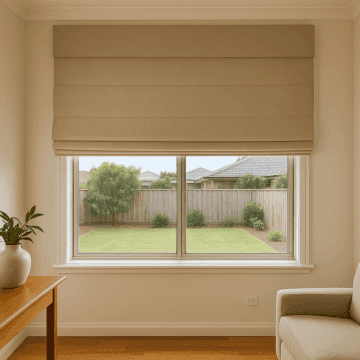Roman blinds—also called Roman shades—marry the crisp lines of a blind with the softness of fabric folds. Because they lift into tidy pleats rather than rolling onto a tube, the style you choose influences light seepage, insulation, and how your fabric pattern is displayed. Whether you need block-out for a nursery, relaxed linen for a coastal lounge, or a dressy pleat for a heritage dining room, form really does follow function. If you prefer modern indoor blinds, take a look here.
This guide unpacks 15 Roman blind styles, complete with real-life photos, average installed prices in AUD, and insider design tips from Adelaide fitters. Costs are based on standard window sizes supplied and installed by a mid-range retailer, giving you a solid ballpark before you book quotes. Throughout the article you’ll see “Roman shades” and “Roman blinds” used interchangeably—they mean the same thing. Ready to find the fold, pleat or cascade that matches your room? Let’s begin with the classic flat style and finish outdoors.
1. Classic Flat Roman Blind
If you picture a Roman blind, it’s probably this one: a simple flat panel that folds into crisp, architectural pleats.
What It Looks Like
Single, uninterrupted fabric panel that stacks in 100–150 mm increments when raised.
Average Cost in Australia
$240–$420 installed for a 600–1800 mm-wide window. Add roughly $100 for motorisation or premium designer cloth.
Ideal Fabrics & Lining Options
Medium-weight cotton or linen blends shine; pair with block-out lining for bedrooms or light-filter lining to showcase prints.
Best Rooms & Décor Pairings
Works a treat in living rooms, studies and kids’ zones, sliding effortlessly into modern, Scandinavian or coastal schemes.
Pros & Cons
- Pros: stacks tightly, shows patterns beautifully, easiest style to DIY.
- Cons: creasing visible on pale plains; can feel too tailored for ultra-relaxed spaces.
2. Relaxed (Soft) Roman Blind
For rooms that call for a little whimsy, the relaxed Roman swaps military-sharp pleats for an easy, draping curve.
What It Looks Like
No horizontal battens; fabric gathers into a gentle “smile” at the bottom when lifted.
Average Cost in Australia
Expect $260–$460 installed. Allow about 10 % extra fabric to create that signature droop.
Fabric & Lining Tips
- Soft linen or gauzy cotton delivers natural fall
- Light interlining adds body without stiffness
Where It Shines
Bedrooms, nurseries, and coastal or farmhouse interiors where casual elegance rules.
Pros & Cons
- Pros: romantic vibe, forgiving of minor measuring errors
- Cons: deeper stack, prone to sag on widths over 2400 mm
3. Hobbled (Looped) Roman Blind
Among the more sumptuous roman blind styles, the hobbled — or looped — version adds padded depth at every fold, keeping the fabric in soft, rolling waves even when fully lowered.
Distinctive Features
Soft folds stay in view when the blind is lowered, creating continuous ripples.
Cost Guide
$320–$540 installed; labour higher for sewn-in rod pockets.
Best Fabrics
Light-to-mid weight cotton, linen or silk blends; horizontals and stripes spotlight the folds.
Design Notes
Brings subtle movement and depth to formal dining rooms or a luxe master suite.
Pros & Cons
Pros: plush texture, hides seam lines.
Cons: tallest stack, harder to vacuum clean.
4. Batten Front Roman Blind
What It Looks Like
Narrow timber or aluminium battens are stitched onto the face of the fabric, forming crisp horizontal bars. When you raise the blind, those battens dictate perfectly even folds and stay visible—almost like timber slats wrapped in cloth.
Price Range in Australia
Budget $280–$480 installed for a 600–1800 mm span. Premium stains, painted battens or motorisation will add to the tally.
Styling & Fabric
Pick solid or lightly textured fabrics—think oatmeal linen or matte velvet—then play with contrasting battens for a Japanese or ultra-modern vibe.
Pros & Cons
- Pros: strong architectural lines, excellent structure, better light block.
- Cons: battens collect dust, can clash with layers like sheers or curtains.
5. Batten Back Roman Blind
With battens stitched to the lining instead of the face fabric, the batten-back Roman shows a smooth, uninterrupted frontage—perfect for bold prints that need centre stage.
Appearance
Front panel stays unbroken; pleats are formed by hidden battens behind the cloth.
Cost
Around $280–$480 installed for 600–1800 mm widths.
Where to Use
Pattern-heavy windows—kitchens, kids’ rooms, or any space where the motif should shine.
Pros & Cons
- Pros: uninterrupted pattern, sleek profile, less dust on battens
- Cons: slightly heavier to lift, relies on robust lining
6. Waterfall Roman Blind
The waterfall Roman is all about subtle movement. Each fold rolls forward rather than tucking underneath, so the fabric drapes in a continuous, evenly layered cascade that still looks tailored when the blind is fully lowered.
Visual Characteristics
Forward-falling pleats drop in perfect succession, creating soft shadows and zero visible battens.
Costing
Budget about $270–$460 installed for a 600–1800 mm span; marginally more if you specify extra-deep folds or motorisation.
Design Suggestions
Solid linens, textured cottons or lightweight wool blends highlight the sleek tiers. A contrast border on the bottom edge adds a custom designer punch.
Room Pairings
Suits streamlined kitchens, minimalist home offices and contemporary apartments where you’d like depth and texture without ornate detailing.
7. Cascade (Knife-Pleat) Roman Blind
The cascade, or knife-pleat Roman, swaps relaxed droops for crisp tailoring. Sewn-in pleats create disciplined layers that read more like bespoke joinery than soft furnishing.
Defining Details
Knife-edge pleats stitched at every fold keep fronts ruler-sharp.
Price Guide
$600–$1400 installed; extra labour for precision folding.
Styling Tips
Pinstripes or micro-geometrics echo the crisp lines—perfect for studies and city apartments.
Pros & Cons
- Pros: high-end hotel polish, excellent shape retention
- Cons: shows puckering on flimsy cloth; less forgiving to measurement errors
8. Aventura (Tiered) Roman Blind
8. Aventura (Tiered) Roman Blind
Description
The Aventura, or tiered Roman, alternates one deep pleat with a shallower pleat, sometimes in two complementary fabrics, to create bold horizontal bands and a lively rhythm across the window.
Average Cost in Australia
Allow $330–$550 installed for a 600–1800 mm opening; add roughly 10–15 % when blending multiple textiles or adding contrast piping.
Design Use
A show-stopping choice for hero panes in eclectic lofts, boho lounges, or children’s rooms that crave colour blocking and pattern play.
Practical Considerations
The layered construction stacks chunkier than flat styles—confirm ceiling clearance, specify robust lift hardware, and enjoy the bonus insulation provided by extra fabric.
9. Austrian (Festoon) Roman Blind
Austrian – often called festoon – Romans crank the drama up several notches, billowing into lavish swags as they lift and pooling like stage curtains when dropped. They’re all about romance and old-world glamour.
Looks
Vertical gathers combine with horizontal folds, creating deep, scalloped ruching from top rail to hem.
Cost Range
$650 –$1500 installed; labour climbs for extra widths, interlining, or hand-tied cords.
Best Fabrics
Shimmering silk dupion, crisp taffeta, or sheer voile; lightweight cloth exaggerates the ruches, heavier cloth feels palatial.
Where to Install
Heritage sitting rooms, boutique hotel suites, formal dining rooms—any space craving a statement backdrop.
Pros & Cons
- Pros: unbeatable theatrical wow-factor, excellent sound softening.
- Cons: dust magnet, tricky to clean, tallest stack height of all roman blind styles.
10. London Roman Blind
Defined by one generous centre pouf flanked by flat wings, the London Roman is a toned-down cousin of the Austrian—romantic but not overly frilly.
Signature Shape
Two deep inverted pleats run vertically to create a single, rounded balloon in the middle while the side panels stay straight, keeping sightlines cleaner than full festoons.
Price (Installed, Australia)
Allow $340–$560 for a standard 600–1800 mm window, with extra charged for pattern-matching or interlining.
Design Tips
Show off statement prints—think oversized florals, toile or damask—because the central pouf acts like a framed artwork.
Best Suitability
Ideal for tall, narrow sashes, bay alcoves or even dressing-room mirrors where a softer silhouette balances hard surfaces without blocking too much glass.
11. Balloon Roman Blind
Look & Feel
The balloon Roman ups the drama with a series of plump, pillowy poufs along the bottom hem. When lifted, each section scoops upward like a party balloon, revealing deep scallops and plenty of fabric volume—perfect for adding softness to hard-edged rooms.
Cost (Installed, Australia)
$580 –$1550 per blind, driven higher by the extra fabric yardage and hand-tacked gathers required.
Ideal Settings
Shabby-chic cottages, nurseries, French provincial kitchens or any space where “cosy and charming” beats “tailored and sharp”.
Fabric Advice
Choose lightweight sheers or washed linen for floaty clouds; add interlining if you want bigger, more structured poufs.
12. Faux Roman (Fixed) Valance
Crave the Roman look without cords or a hefty budget? A fixed valance delivers the illusion in one tidy strip of fabric.
What It Is
Fabric is stapled to a headboard and pinched into permanent folds—purely decorative.
Cost
From $180–$300 installed; underlying working blind costs extra.
Use Cases
Great over rollers in rentals, bathrooms or splash-zone kitchens.
Pros & Cons
- Adds colour cheaply
- No light control, cannot lift
13. Motorised Roman Blind
Want your window covering to glide up with a tap on your phone? Add a slim motor to the headrail and every raise-and-lower becomes smooth, silent and totally cord-free—a big win for child safety and hard-to-reach windows.
Defining Feature
- Compact 240 V plug-in, rechargeable lithium battery or solar motor concealed inside the track
- Operated by handheld remote, wall switch, Siri/Google/Alexa voice or a whole-home automation hub
Cost Breakdown
Manual blind price plus $440 –$750 for the motor kit and programming. Typical installed total: $500–$900 depending on width, power option and smart-home brand.
Compatibility
Nearly any Roman style can be motorised, but flat and waterfall designs are the easiest because the stack is lighter and cords run straight.
Benefits & Trade-Offs
Pros:
- Tangle-free and child-safe
- Set schedules for heat control
- Integrates with existing smart lights and sensors
Cons:
- Higher upfront outlay
- Battery packs need recharging every 9–18 months (size and usage dependent)
14. Top-Down / Bottom-Up Roman Blind
How It Works
A clever dual-lift system lets the blind stack either at the sill or drop from the top rail, so you can expose just the slice of glass you want. Two cords (or a split motor) run through independent tracks, keeping the fabric perfectly level no matter which end you move.
Price (Installed, Australia)
Add roughly 15 % to the cost of a comparable manual style. Most windows land between $550 –$1350 supplied and fitted.
Best Applications
Ground-floor bedrooms, street-facing bathrooms and apartment blocks where you crave daylight but refuse to sacrifice privacy. Also brilliant for windows that get harsh overhead sun during summer afternoons.
Design Note
Stick to lightweight linens or cottons; heavy interlining strains the twin lift system. Face-mounting gives a cleaner look and prevents cords rubbing on the window reveal.
15. Outdoor Roman Blind
Outdoor Romans lend patios and pergolas neat folds in fabric tough for Aussie weather.
Characteristics
UV-stabilised acrylic canvas or PVC mesh rides stainless cables, stacking into broad pleats by cord or crank.
Cost Range
$380–$720 per m² installed; pelmets or motors add to the bill.
Benefits
- Cuts glare and up to 90 % heat
- Shields furniture and fabrics
- Gives privacy yet airflow
Install Tips
- 316 stainless fittings
- Pelmet for runoff
- Hem hold-downs in gusts
Pros: stylish shade. Cons: heavier lift, periodic tension tweaks.
How to Choose the Right Roman Blind for Your Space
So many roman blind styles looks exciting on Pinterest—until you have to pick just one for your own window. The trick is to balance architecture, day-to-day function and fabric performance before you swipe your card. Use the framework below to narrow the field. Learn how to maximize your indoor blinds in your home here.
Match Style to Architectural Setting
Different homes speak different “design languages”. Match the fold to the façade and you’ll never feel like the window is wearing the wrong outfit.
- Federation cottage – Hobbled or London for gentle heritage curves
- Hamptons coastal – Relaxed linen or waterfall in chalky whites
- Mid-century modern – Flat or batten-front with walnut battens
- Industrial loft – Cascade (knife-pleat) in charcoal canvas
- Contemporary new build – Motorised flat or top-down/bottom-up for clean lines
Practical Considerations
Before you obsess over fabric books, run through these quick checks:
- Light control required? (block-out lining for bedrooms, sheer for living)
- Insulation needs: interlining adds up to 30 % more R-value
- Privacy vs. view: top-down options keep nosy neighbours out while letting sky in
- Window access: avoid deep stacks behind inward-opening casements or patio doors
- Headroom: allow the stack height shown in our cost table, plus 20 mm safety margin
Fabric, Lining & Colour Checklist
| Fabric Weight | Typical Drape | Best Styles | Notes | |---------------|--------------|-------------|-------| | Sheer (<150 gsm) | Fluid, airy | Relaxed, Balloon | Needs stabilising tape | Medium (150-300 gsm) | Controlled fold | Flat, Waterfall, Batten | Most versatile | Heavy (>300 gsm) | Structured | Cascade, Austrian | Confirm lift capacity |
Block-out, dim-out, thermal and poly-cotton linings can be mixed and matched; choose colour-matched thread so stitch lines disappear.
Measuring & Ordering Like a Pro
- Decide recess fit (inside frame) or face fit (overlap by 70 mm each side for better light block).
- Measure width at top, middle and bottom; record the narrowest.
- Measure drop left and right; use the longest.
- Deduct 5 mm from width for recess blinds so they don’t rub.
- Mark obstructions—locks, handles, tiles—on the quote sheet.
Hand these numbers to your installer and ask for written confirmation of finished blind size, not just window size. A five-minute double-check now beats an expensive re-cut later. Then hop on over to our indoor blind inspo, with some beautiful roman blind pics.
Roman Blind Costs at a Glance (Quick Table)
Quickly compare the fifteen roman blind styles on price, bulk when stacked, and how hard they are to tackle as a weekend project.
| Style | Installed Cost* | Stack | DIY Skill |
|---|---|---|---|
| Classic Flat | $240–420 m2 | Low | Easy |
| Relaxed | $260–460 m2 | Med | Moderate |
| Hobbled | $320–540 m2 | High | Hard |
| Batten Front | $280–480 m2 | Low | Moderate |
| Batten Back | $280–480 m2 | Low | Moderate |
| Waterfall | $270–460 m2 | Med | Moderate |
| Cascade | $300–520 m2 | Med | Hard |
| Aventura | $330–550 m2 | High | Hard |
| Austrian | $400–650 m2 | Very High | Hard |
| London | $340–560 m2 | High | Moderate |
| Balloon | $360–580 m2 | High | Hard |
| Faux Valance | $180–300 m2 | Nil | Easy |
| Motorised | $500–900 m2 | Varies | Easy |
| Top-Down/Bottom-Up | $320–550 m2 | Low | Moderate |
| Outdoor | $380–680 /m² | Med | Specialist |
Money-saving tip: order multiple blinds in the same fabric to cut setup fees and ask for “in-stock” cloth to dodge custom surcharges.
*Costs are ballpark figures for a 600–1800 mm window, supplied and fitted in metro Australia. Prices rise with choice of fabrics, automation & difficult installs.
Care, Cleaning & Maintenance Essentials
Roman blinds last decades in Adelaide’s sun if you give them a little TLC. Most mishaps—faded fabric, grimy hems, tangled cords—are preventable with the right weekly and annual habits.
Everyday Cleaning
- Close the blind fully, then vacuum with a soft brush attachment, working from top to hem.
- For pet hair, run a lint roller or lightly damp microfibre cloth along the folds.
- Give battens and headrail a quick dust to stop grit wearing the lift cords.
Deep Cleaning & Stain Removal
Spot-clean spills the moment they happen using a mild dish-soap solution (1 tsp detergent : 1 cup lukewarm water). Blot—don’t rub—to avoid spreading the mark.
Interlined, silk or blackout-coated fabrics should never be steamed; moisture can bubble the lining. Instead, unhook and send them for professional dry-cleaning every 2–3 years, noting the “Roman blind, no tumble” instruction on the docket.
Repair Tips
- Replace frayed cords with 1 mm polyester blind cord—feed through existing rings.
- Tighten or swap cracked battens; pre-drill timber replacements to prevent splitting.
- If a clutch or motor groans, call a licensed installer before further damage occurs.
Frequently Asked Questions
Below are the queries we’re asked most often during in-home consults. If you still need clarification after this lightning round, jot your question down and our Adelaide team can cover it during your free measure.
Are Roman blinds energy-efficient?
Yes—when you add block-out or thermal lining, the pleated fabric forms an insulating air pocket similar to a quilt. A lined Roman can lift the window’s R-value by 0.4–0.6, trimming summer heat gain and winter heat loss. For maximum savings, mount the blind outside the reveal and add a pelmet to seal the top edge.
Can Roman blinds be outside-mounted?
Absolutely. Face-mounting lets you order the blind a good 70–100 mm wider and longer than the frame, which blocks more light and hides imperfect architraves. Just remember the stack will sit above the window—make sure you have enough wall or bulkhead clearance.
What’s the maximum workable width?
Manual Romans are comfortable up to about 2400 mm wide. After that, cord tension increases and fabric can belly. Motorisation and joined centre panels can extend the span to 3000 mm, but expect heavier hardware and a higher price tag.
Do Roman blinds suit bay or corner windows?
They do, provided each pane gets its own blind. Measure every section individually, share a continuous headboard if angles allow, and specify side-exit cords so the pulls don’t clash in the bay. Allow an extra 5 mm gap between blinds to avoid rubbing when you raise them.
Bringing It All Together
Fifteen styles, from ruler-straight flat Romans to theatrical Austrians, give you endless ways to filter light and stamp personality on a room. Narrow the list by asking three quick questions:
- Budget – simple flats start around $550, while ruching, motors or outdoor hardware push costs north of $600.
- Function – block-out lining for sleep, top-down privacy for neighbours, outdoor acrylic for alfresco glare.
- Mood – crisp battens for modern minimalism, relaxed linen for coastal calm, pleated cascades for tailored polish.
Match those answers with fabric weight, stack clearance and your home’s architecture and you’ll land on the perfect fold. Still unsure? Our Adelaide team measures, quotes and even mocks up fabric swatches in your space free of charge. Book an in-home consult or drop into the showroom by visiting Classic Roller Shutters today.




